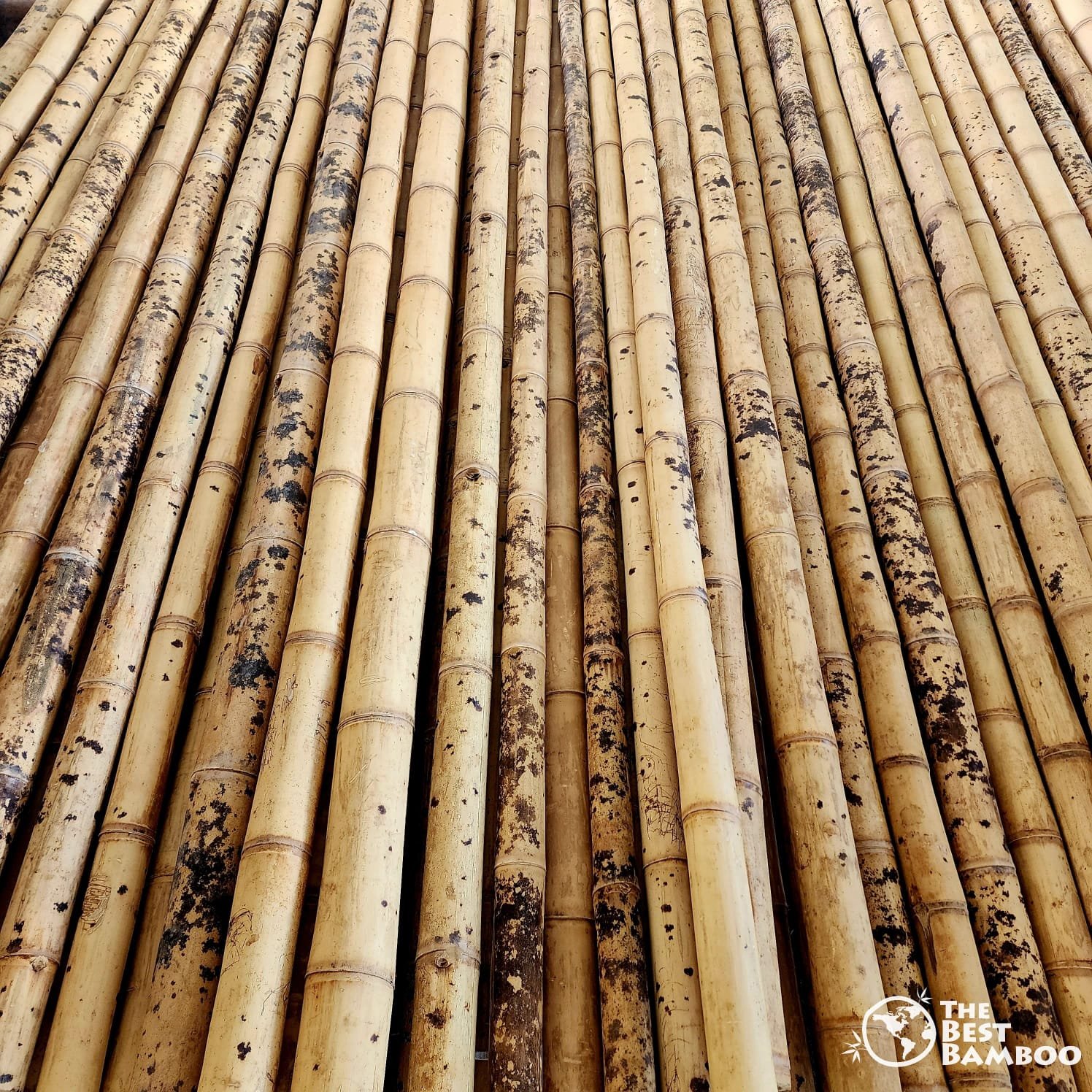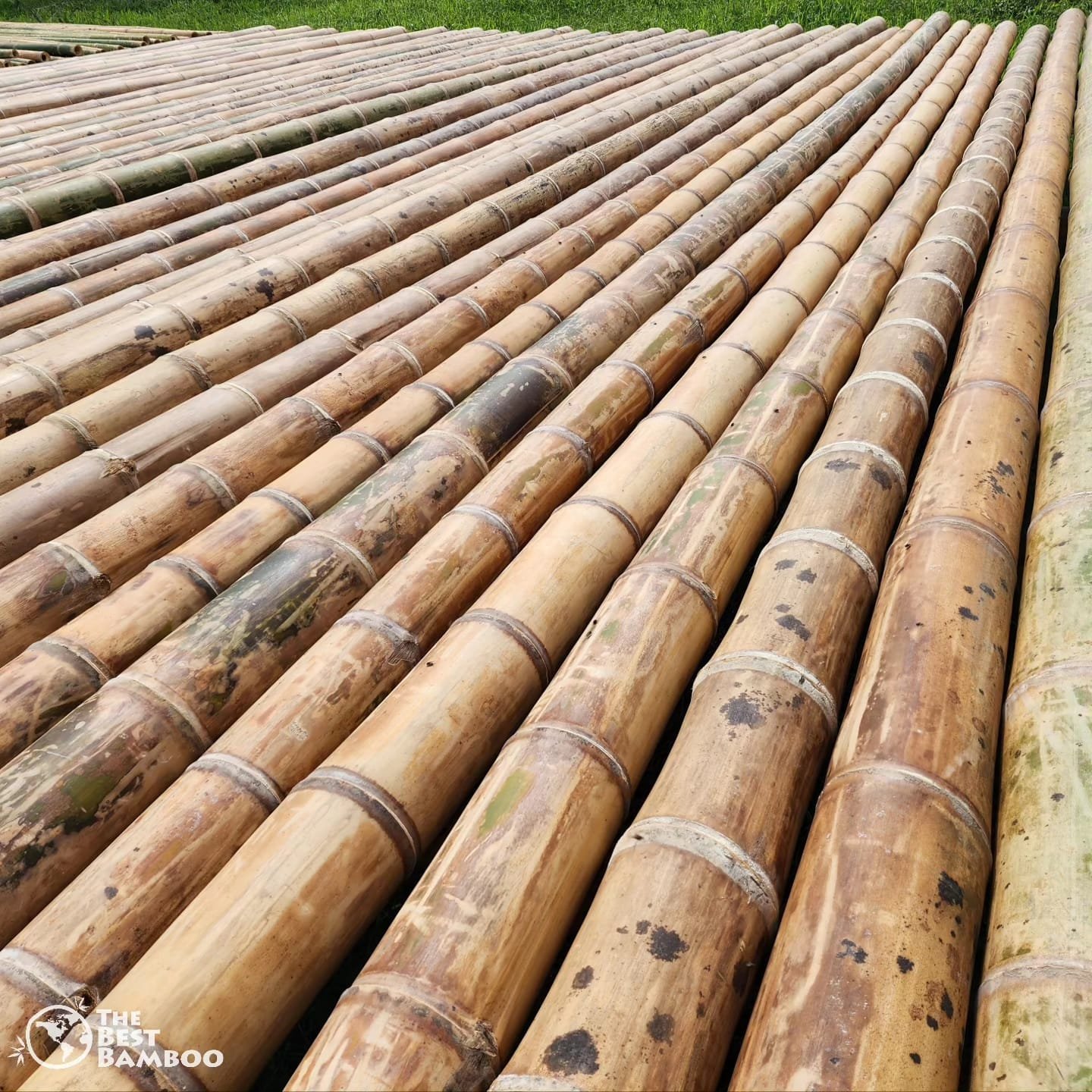Identifying and Treating Dark Spots on Guadua Bamboo Poles
Guadua bamboo is a type of bamboo species that is widely used for construction purposes due to its strength and durability. It is native to the tropical regions of South America and can grow up to 30 meters in height. The outer layer of guadua bamboo, known as the cuticle, is what is typically covered with a type of "freckles" or "spots" that have been causing lots of attention due to its fascinating look and feel. Basically the dark spots found on Guadua poles are not merely imperfections but rather unique features that add to the natural beauty and distinctiveness of Guadua. This distinctive feature has led to the marketing of guadua with dark spots as “Tiger Guadua” or “Tiger Bamboo” at premium prices, highlighting its exceptional quality!
Understanding Dark Spots on Guadua Bamboo
Dark spots on the outer layer of guadua bamboo poles are a common occurrence, but their exact cause is yet unknown. It is believed that these stains origin from lichens, a type of fungi that grows in humid environments and becomes visible on the bamboo more or less in year 3 or 4 . What we are certain is that these stains do not affect the overall strength or shape of the bamboo, but they may pose aesthetic challenges for commercial use.
Are Dark Spots a Sign of Mold, Rot, or Defects?
It's a common misconception that the dark spots found on guadua bamboo were caused by mold, rot, or other flaws—rest assured, that's not the case! Unlike classic signs of bamboo deterioration, these unique spots do not result from fungal decay or structural issues. Instead, they're entirely natural features, often appearing as the bamboo matures in its ideal growing environment. In fact, their striking appearance has made "Tiger Bamboo" highly sought after in the design and architecture worlds, fetching premium status much like the signature look of a Dalmatian or a rare marble countertop.
What Causes the Dark Spots on guadua bamboo poles?
The exact causes for dark spots on guadua bamboo poles are yet unknown and still a subject of debate. Factors such as the temperature where bamboo grows, humidity, and the natural aging process of bamboo may contribute to the development of these spots. However, more research is needed to determine the precise conditions under which these stains appear.
While the precise reason for the appearance of dark spots on the outer layer of Guadua bamboo poles remains a bit of a mystery, most experts point to lichens as the prime suspects. Lichens—those quirky, resilient fungi you might spot on tree bark, river stones, or even the side of an old garden shed—love humid environments like the ones Guadua calls home. Over time, typically around the third or fourth year of growth, these lichens make themselves at home on the bamboo’s surface. Through their natural life processes, they leave behind the telltale dark freckles that have become a signature trait of Guadua bamboo.
It's important to note these spots arise as part of nature’s own handiwork, marking bamboo that’s thriving in its environment rather than showing signs of weakness or disease. The only certainty we have is that these spots tend to appear on bamboo that is at the optimal stage for harvesting, indicating the perfect timing to bring the bamboo to our treatment plant!
Does Cattle Proximity Influence BAMBOO Dark Spot Formation?
Interestingly, observations from guadua plantations across Colombia suggest that the environment plays a bigger role than one might think—especially when it comes to cattle! Bamboo poles growing near areas grazed by cattle often tend to show more pronounced dark spots, compared to those growing farther away from herds.
Why might this happen? The likely culprits are increased ammonia levels and changes in soil pH caused by cattle waste. These conditions could encourage chemical reactions or even enhance lichen activity on the bamboo’s surface, potentially explaining the greater frequency of dark spots in these areas. While the scientific community is still unraveling the exact mechanism, farmers and researchers alike have noticed this fascinating correlation in the field.
The Best Bamboo Guadua Forest
Effect of Dark Spots on Guadua Bamboo
Dark spots on guadua bamboo do not affect the structural integrity of the material. They are purely cosmetic and do not impact the overall performance or lifespan of the bamboo poles. Therefore, while these spots can be challenging for certain applications, they do not pose any problems for the practical use of guadua bamboo in construction projects.
Identifying Dark Spots on Guadua Bamboo Poles
Visual Inspection
When visually inspecting the guadua bamboo poles, pay attention to any discoloration or staining on the surface. Dark spots appear as patches or specks on the outer layer of the poles. These spots can vary in size and shape, and they may be more concentrated in certain areas.
The Best Bamboo - Spotted Guadua
Touch and Feel
In addition to visual inspection, it is also helpful to touch and feel the surface of the bamboo poles to identify any dark spots. Run your hands along the length of the poles and pay attention to any areas that feel rough or uneven. Dark spots could cause a slight texture difference in the affected areas, which can be detected by touch. This tactile inspection can help confirm the presence of dark spots on the bamboo poles.
Treating Dark Spots on Guadua Bamboo
While dark spots on guadua bamboo do not affect the structural integrity of the material, they may be unfavorable for certain business uses. Fortunately, there are ways to treat and minimize the appearance of these spots.
Sanded and Stained Spotted Guadua Bamboo Poles
Remedial Measures
If dark spots do appear on the guadua bamboo poles, there are remedial measures that can be taken to minimize their appearance. One approach is to sand down the affected areas to create a more consistent look. Another method is to apply a protective coating or stain to the poles to mask the dark spots. These measures can help improve the overall aesthetic of the guadua bamboo poles.
Cultural and Aesthetic Perceptions of Dark Spots
How dark spots on Guadua bamboo are viewed can differ dramatically depending on where you are in the world. In many of the tropical, bamboo-rich regions of South America—where guadua makes up a vital part of cultural and daily life—these speckles are seen as badges of authenticity. Rather than flaws, locals often regard the dark spots as proof of the bamboo’s natural origin, each pole revealing a story of growth shaped by climate, soil, and time. They celebrate these patterns much in the same way woodworkers appreciate the unique knots and grain in solid wood. The spots are simply part of what makes each piece of guadua one-of-a-kind.
Meanwhile, in markets such as Europe and North America, where polished uniformity in construction materials is prized, the dark spots can be met with mixed feelings. Some see them as oddities, perhaps mistaking them for blemishes or damage. However, growing appreciation for sustainable design and natural aesthetics has led many architects, furniture makers, and designers to treat spotted Guadua—now nicknamed “Tiger Bamboo”—as a premium, artisanal material. It’s not uncommon to find “Tiger Bamboo” featured in eco-friendly design showcases from Tokyo to New York, where brands like Herman Miller and Vitra have helped reframe natural variation as a sought-after feature.
This range of cultural perspectives highlights how the meaning of a simple spot can shift with context—transforming it from a mark to be concealed into a celebrated hallmark of Guadua’s wild, natural beauty.
Bonus: info on Guadua!
Firstly a great fact: Guadua is not a tree, its a grass that outperforms any wood! Also there are over 1800 types of bamboo, each with its own unique characteristics. Without any doubt, Guadua bamboo is often a popular choice for construction due to its strength and durability. Other bamboo species have different properties, such as size, shape, and growth patterns. Understanding the differences between these species can help determine the most suitable bamboo for specific projects.
Guadua Bamboo vs Other Species
Compared to other bamboo species, guadua bamboo stands out for its exceptional structural integrity and resistance to pests and diseases. It grows up to 30 meters in height and has a thick outer layer, known as the wall, its culm provides excellent support for construction purposes. Additionally, guadua bamboo is known for its fast growth rate, making it a sustainable choice for building materials.
Commercial Uses of Guadua Bamboo
Guadua bamboo has a wide range of commercial applications due to its strength, durability, and versatility. It can be used in various construction projects, such as building structures, scaffolding, furniture, flooring, and decorative elements. Additionally, guadua bamboo is used in the manufacturing of musical instruments, handicrafts, and even as a renewable source of energy.
Possible Applications
The possibilities for using Guadua bamboo in commercial projects are virtually endless. Its strength and flexibility make it suitable for load-bearing structures, such as beams, columns, and trusses. It can also be used for wall cladding, roofing, and floorings. Furthermore, guadua bamboo's natural beauty and unique grain pattern make it an attractive material for furniture, crafts, and artistic installations.
Growing Guadua Bamboo
Guadua bamboo thrives in tropical climates, preferring temperatures between 20 to 30 degrees Celsius. It requires well-drained soil with adequate moisture and a high humidity level. Proper cultivation techniques and maintenance are essential to ensure optimal growth and maximum yield of quality bamboo poles.
Climate Requirements
Guadua bamboo is native to tropical regions and is best suited for areas with a consistent warm climate. It requires ample sunlight and regular rainfall or irrigation to maintain optimal growth. Extreme temperatures or prolonged droughts can negatively impact the development of guadua bamboo, affecting its strength and overall quality.
Cultivation Techniques
The cultivation of guadua bamboo involves several techniques to ensure its healthy growth and productivity. This includes proper soil preparation, including adequate drainage and nutrient enrichment. Planting methods such as direct planting or transplantation of seedlings play a crucial role in establishing a robust bamboo plantation. Regular maintenance, such as pruning and weed control, is also important to maintain the health and productivity of the bamboo.


















